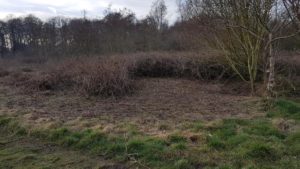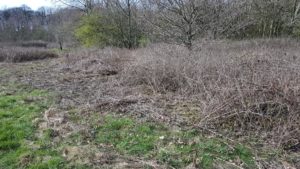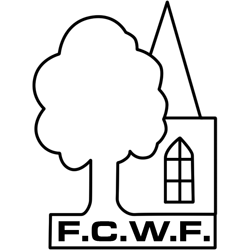Bramble management is crucial on the fields where the patches of brambles grow so large they threaten to damage the vegetation around them. If left unchecked brambles will creep across large areas covering other vegetation and changing the nature of the woods and fields.

A team from the Trust for Conservation Volunteers (TCV) spent half a day cutting back the brambles across the top field to allow the vegetation to re-establish. Six weeks on from this and already grass and small wildflowers can be seen growing where there had once been only brambles.

The brambles will continue to creep over the fields unless effort is continually put into managing them. Only a fraction of the brambles were cleared at this time and much more work is needed to keep paths clear and allow a diversity of vegetation to reappear, not only on the top field but on the other levels also.
Friends of Childwall Woods and Fields review the situation constantly and are planning further work in the months to come.


This article reads like bramble is an invasive, unwanted species, when it forms a crucial part of the scrub/woodland dynamic. They provide nectar for rare butterflies and moths, protection for nesting birds (e.g. Robins, wrens, thrushes, blackbirds, warblers and finches), habitat for small mammals (e.g. dormice, voles and hedgehogs), food for a variety of birds and insects, and their berries are a vital food source later in the year.
It is remiss to not acknowledge the vital part bramble plays in mammal and insect diversity within woodland/scrub areas. When you say “much more work needs to be done”, I hope you keep the above in mind.
Thanks for browsing the site and for your very interesting and valid points about the importance of brambles in the bigger picture of the ecosystem. FCWF totally agree that brambles are ‘crucial’ in providing shelter and sustenance for a variety of wildlife and do not want to eliminate them completely from the area, just trim them back so that grasses and wildflowers can become reestablished on the fields. There is ‘much more work to be done’ on the site pushing back the huge bramble patches but we would not want to get rid of them totally, rather to stop them creeping across the whole site.
In part 2 of the ecology page which is still under construction, the habitat of the wildlife on the site will be described, then the importance of the scrubland will certainly be acknowledged.
Thank you for your input.